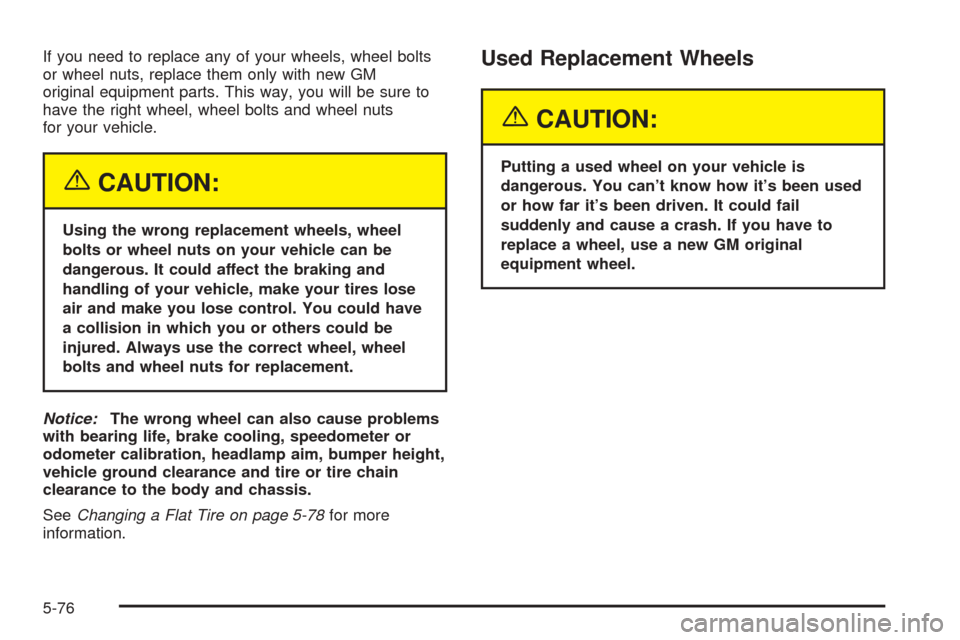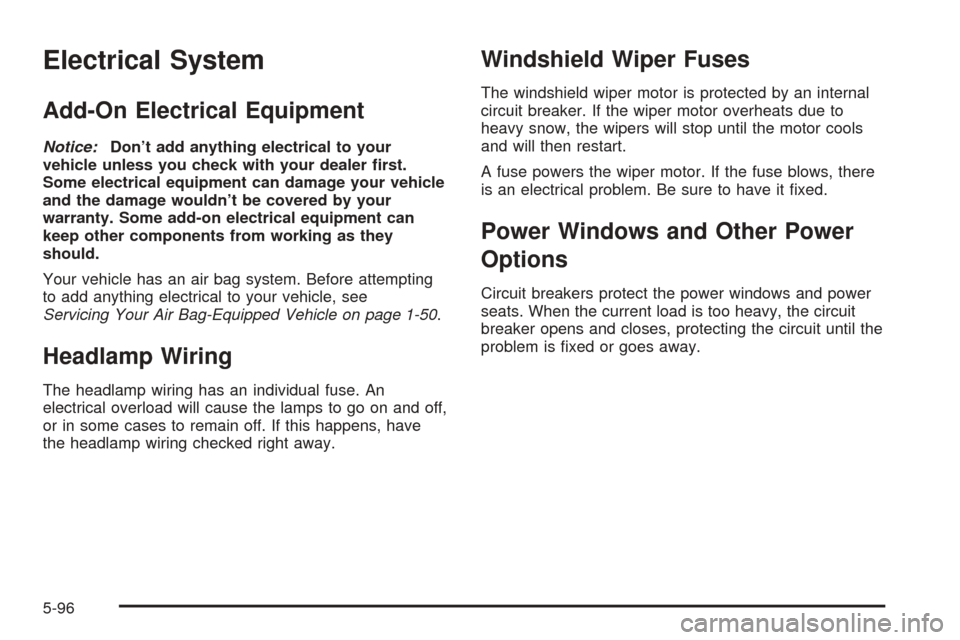Page 312 of 410
3. At the wall or other flat surface, measure from the
ground upward the recorded distance from Step 2
and draw or tape a horizontal line the width of
the vehicle.
Notice:Do not cover a headlamp to improve beam
cut-off when aiming. Covering a headlamp may
cause excessive heat build-up which may cause
damage to the headlamp.4. Turn on the low-beam headlamps and place a
piece of cardboard or equivalent in front of the
headlamp not being aimed. This should allow only
the beam of light from the headlamp being
aimed to be seen on the flat surface.
5-52
Page 313 of 410
5. Turn the vertical aiming screw (C) until the
headlamp beam is aimed to the horizontal tape line.
The top edge of the cut-off should be positioned
at the bottom edge of the horizontal tape line.
6. Repeat Steps 4 and 5
for the opposite
headlamp.
Bulb Replacement
For the proper type of replacement bulb, see
Replacement Bulbs on page 5-59.
For any bulb changing procedure not listed in this
section, contact your dealer.
High Intensity Discharge (HID)
Lighting
{CAUTION:
The low beam high intensity discharge lighting
system operates at a very high voltage. If you
try to service any of the system components,
you could be seriously injured. Have your
dealer or a qualified technician service them.
Your vehicle may have HID headlamps. After your
vehicle’s HID headlamp bulb has been replaced, you
may notice that the beam is a slightly different
shade than it was originally. This is normal.
5-53
Page 314 of 410
Halogen Bulbs
{CAUTION:
Halogen bulbs have pressurized gas inside
and can burst if you drop or scratch the bulb.
You or others could be injured. Be sure to read
and follow the instructions on the bulb
package.
Headlamps
1. Open the hood.
2. Remove the upper filler panel by loosening all the
screws and then removing the grommets.3. Remove the two bolts fastening the headlamp to
the headlamp mounting bracket.
4. Pull the headlamp straight forward to disengage the
locator pin at the outboard edge of the headlamp.
5-54
Page 316 of 410
7. Remove the headlamp bulb socket. 8. After removing the wiring harness connector from
the headlamp bulb socket, replace the bulb
assembly. Reconnect it to the wiring harness and
reinstall the headlamp bulb assembly back into
the headlamp housing.
5-56
Page 317 of 410
9. After reinstalling the bulb and socket, reinstall the
rubber cover. Make sure it fully covers the
headlamp socket.
10. To replace the high-beam bulb, turn the bulb socket
counterclockwise to unlock the socket from the
lamp housing. Follow the instructions in
Step 6 through 8 to install the new bulb.
11. Reinstall the upper filler panel by inserting the
grommets, along with the screws, back into
the holes.Front Turn Signal Lamps
1. The turn signal lamps are located on the outboard
side of the headlamps. To access, remove the
headlamp. See Steps 1, 2, 3, and 10 under
Headlamps on page 5-54.
2. Press the bulb socket tab and turn the bulb socket
counterclockwise to unlock the socket from the
lamp housing.
3. To remove the old bulb, grasp the socket firmly and
pull the bulb out.
4. Install the new bulb and reverse the steps to
reinstall the lamp housing.
5-57
Page 319 of 410
7. Press the bulb socket tab and turn the socket
counterclockwise to remove it. To remove the
bulb, grasp the socket firmly and pull the bulb out.
Once you have replaced the burned-out bulb, reverse
the steps to reassemble the lamp assembly.
Replacement Bulbs
For any bulb not listed here contact your dealer.
Exterior Lamp Bulb Number
Front Turn Signal 2357NA
Headlamps, Composite
High Beam
Low Beam9005HB3
9006HB4
Rear Turn Signal 3057
Stop/Taillamp 3057
5-59
Page 336 of 410

If you need to replace any of your wheels, wheel bolts
or wheel nuts, replace them only with new GM
original equipment parts. This way, you will be sure to
have the right wheel, wheel bolts and wheel nuts
for your vehicle.
{CAUTION:
Using the wrong replacement wheels, wheel
bolts or wheel nuts on your vehicle can be
dangerous. It could affect the braking and
handling of your vehicle, make your tires lose
air and make you lose control. You could have
a collision in which you or others could be
injured. Always use the correct wheel, wheel
bolts and wheel nuts for replacement.
Notice:The wrong wheel can also cause problems
with bearing life, brake cooling, speedometer or
odometer calibration, headlamp aim, bumper height,
vehicle ground clearance and tire or tire chain
clearance to the body and chassis.
SeeChanging a Flat Tire on page 5-78for more
information.
Used Replacement Wheels
{CAUTION:
Putting a used wheel on your vehicle is
dangerous. You can’t know how it’s been used
or how far it’s been driven. It could fail
suddenly and cause a crash. If you have to
replace a wheel, use a new GM original
equipment wheel.
5-76
Page 356 of 410

Electrical System
Add-On Electrical Equipment
Notice:Don’t add anything electrical to your
vehicle unless you check with your dealer first.
Some electrical equipment can damage your vehicle
and the damage wouldn’t be covered by your
warranty. Some add-on electrical equipment can
keep other components from working as they
should.
Your vehicle has an air bag system. Before attempting
to add anything electrical to your vehicle, see
Servicing Your Air Bag-Equipped Vehicle on page 1-50.
Headlamp Wiring
The headlamp wiring has an individual fuse. An
electrical overload will cause the lamps to go on and off,
or in some cases to remain off. If this happens, have
the headlamp wiring checked right away.
Windshield Wiper Fuses
The windshield wiper motor is protected by an internal
circuit breaker. If the wiper motor overheats due to
heavy snow, the wipers will stop until the motor cools
and will then restart.
A fuse powers the wiper motor. If the fuse blows, there
is an electrical problem. Be sure to have it fixed.
Power Windows and Other Power
Options
Circuit breakers protect the power windows and power
seats. When the current load is too heavy, the circuit
breaker opens and closes, protecting the circuit until the
problem is fixed or goes away.
5-96